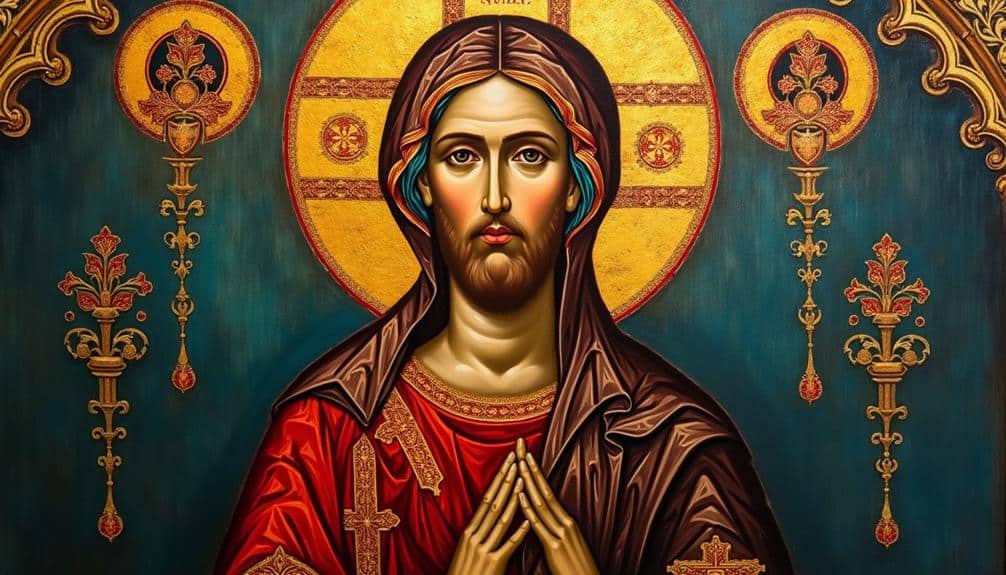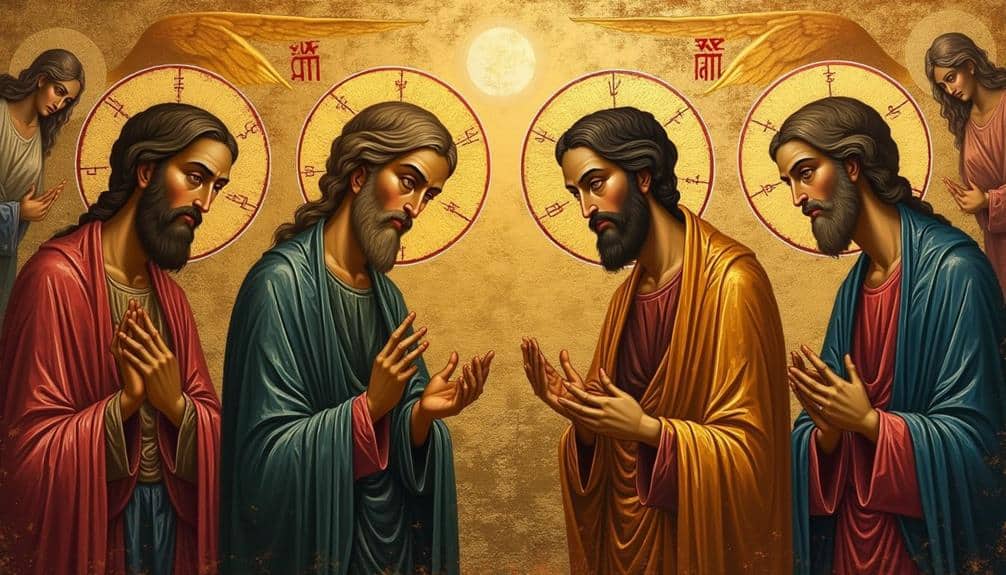Examining the symbolism of Russian Orthodox icons reveals a rich interplay of theological and spiritual dimensions embedded in color, gesture, and narrative. The use of gold to denote divine light and blue to represent purity, for instance, reveals a sophisticated visual language intended to deepen faith. The gestures and postures of the depicted figures are not merely artistic choices but are laden with profound meaning, inviting the observer to a deeper contemplation of their spiritual significance. Moreover, the portrayal of saints and biblical scenes as active participants in faith transforms these icons into powerful visual homilies, inviting a closer look.
Historical Background

The historical background of Russian Orthodox icons is deeply rooted in the Byzantine tradition, which profoundly influenced Eastern Orthodox Christianity. This influence began in the late 10th century when Prince Vladimir of Kiev adopted Christianity as the state religion, bringing Byzantine culture and religious practices into the region.
The iconography evolution in Russia was markedly shaped by these early interactions with Byzantine artists and theologians, establishing a distinctive style that would later evolve.
Cultural influences played an essential role in the development of Russian iconography. Initially, Russian icon painters closely adhered to Byzantine techniques and artistic conventions. However, over time, as local traditions and religious sentiments permeated the practice, a uniquely Russian style emerged. This evolution was marked by a greater emphasis on emotional expression and narrative detail, reflecting the spiritual and cultural milieu of the Russian people.
Furthermore, the Mongol invasion in the 13th century and subsequent periods of political upheaval did not halt the artistic progression but rather enriched it. The isolation from Western Europe allowed Russian iconography to develop independently, incorporating indigenous elements and symbols.
Consequently, the historical background of Russian Orthodox icons is a reflection of the dynamic interplay of cultural influences and the iconography evolution within a deeply spiritual context.
Color Symbolism
Understanding the development of Russian Orthodox icons requires an exploration of the intricate symbolism embedded within their colors. The use of color in these sacred images is far from arbitrary; each hue carries profound theological and spiritual significance, meticulously chosen to convey deeper meanings.
For instance, gold symbolizes divine light and the uncreated energy of God, rendering a sense of heaven’s timeless and infinite nature. Blue, often associated with the Virgin Mary, signifies purity and transcendence, while red represents the Holy Spirit, martyrdom, and resurrection, invoking the passion and sacrifice of Christ.
The color meanings in Russian Orthodox icons are deeply rooted in both tradition and theological doctrine, guiding the faithful towards a richer understanding of their faith. Artists employ specific artistic techniques to guarantee that these symbolic colors are vibrant and enduring.
The use of natural pigments and tempera, often applied on a wooden panel covered with gesso, allows the colors to remain vivid and expressive over centuries. This careful selection and application of colors serve not merely as decoration but as a visual theology, assisting the worshiper in contemplating the divine mysteries and the sacred narratives depicted within these icons.
Gestures and Postures

Frequently overlooked yet profoundly significant, gestures and postures in Russian Orthodox icons are imbued with deep theological meaning. These elements serve not merely as artistic choices but as conduits of divine truth and spiritual instruction.
Hand positions, for instance, are meticulously crafted to convey specific blessings, teachings, or intercessions. The right hand of Christ is often depicted in a gesture of blessing, with fingers arranged to form the Greek letters ICXC, symbolizing Jesus Christ. This hand position is not arbitrary; it is a visual articulation of His divine authority and benevolence.
Facial expressions also play a vital role in communicating the spiritual state of the figures portrayed. The serene and compassionate expressions of saints and the Theotokos (Mother of God) resonate with the peace and grace that believers aim to emulate. Conversely, more intense facial expressions can be found in depictions of martyrdom or divine judgment, underscoring the gravity of these themes.
The postures of the figures further enhance this symbolic language. Whether standing, kneeling, or enthroned, each posture signifies a particular aspect of their spiritual journey or divine role.
Collectively, these gestures and postures invite viewers into a deeper contemplation of the sacred mysteries they represent.
Depiction of Saints
Integral to the spiritual and cultural fabric of Russian Orthodoxy, the depiction of saints in icons serves as a visual theology that bridges the divine and the earthly. Saints are portrayed not merely as historical figures but as living participants in the ongoing narrative of faith. In this sacred art form, saint attributes are meticulously depicted to convey their virtues, roles, and heavenly intercessions. For instance, Saint Nicholas is often shown holding a book of Gospels and blessing with his right hand, symbolizing his role as a miracle worker and protector.
Iconography styles in Russian Orthodox icons are distinct, adhering to traditional canons that maintain uniformity and theological accuracy. The saints are usually painted with elongated bodies and serene, contemplative expressions, emphasizing their spiritual transcendence. Their garments are adorned with symbolic colors—gold for divinity, red for martyrdom, and blue for heavenly origin.
Additionally, the use of halos signifies their sanctity and divine light. The deliberate and consistent depiction of saints through saint attributes and specific iconography styles fosters a deeper connection with the divine, guiding the faithful in their spiritual journey and reinforcing the timeless truths of the Orthodox faith.
Biblical Scenes

Biblical scenes in Russian Orthodox icons vividly capture pivotal moments from the Scriptures, serving as both theological reflections and visual homilies. These iconic narratives distill complex theological doctrines into accessible visual forms, enabling the faithful to engage with the spiritual significance of the depicted events.
From the Nativity to the Crucifixion and Resurrection, each icon is meticulously crafted to convey profound religious truths. The Nativity icon, for instance, does more than depict the birth of Christ; it encompasses a range of theological themes, including the Incarnation and the fulfillment of Old Covenant prophecies.
Similarly, icons of the Crucifixion are not mere representations of historical events but visual meditations on the sacrifice and redemption at the core of Christian belief. The Resurrection icons encapsulate the triumph of life over death, embodying the hope and promise of eternal life.
Each scene is imbued with layers of meaning, encouraging deeper contemplation and understanding. The use of symbolic colors, postures, and compositions further enriches these depictions, transforming them into didactic tools that guide the viewer through the spiritual landscape of Christian theology.
In this way, Russian Orthodox icons serve as both art and scripture, illuminating the path to spiritual enlightenment.




